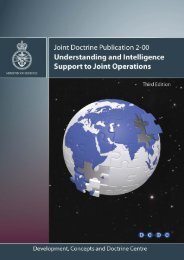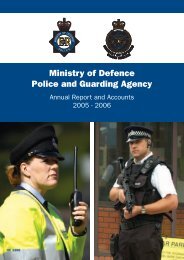Andrew Robathan MP - Ministry of Defence
Andrew Robathan MP - Ministry of Defence
Andrew Robathan MP - Ministry of Defence
Create successful ePaper yourself
Turn your PDF publications into a flip-book with our unique Google optimized e-Paper software.
z Where an individual suffers multiple<br />
injuries from a single incident but two<br />
or more body zones are not affected, or<br />
the individual does not sustain a tariff<br />
level 11 injury in at least two zones, the<br />
lump sum amount will be calculated on<br />
the following basis: 100% <strong>of</strong> the lump<br />
sum for the most serious injury is paid,<br />
80% <strong>of</strong> the lump sum for the second<br />
most serious injury, 60% <strong>of</strong> the lump<br />
sum for the third most serious injury,<br />
40% <strong>of</strong> the lump sum for the fourth<br />
most serious injury, 20% <strong>of</strong> the lump<br />
sum amount will be paid for the fifth<br />
and each subsequent injury.<br />
The rules have been constructed in this way to<br />
ensure the Scheme’s principle <strong>of</strong> being fair is<br />
not breached. The Review considered that an<br />
individual with multiple injured body zones<br />
was more disadvantaged than someone with<br />
only one injured body zone. If the zoning<br />
approach was applied to all multiple injury<br />
cases an individual who sustained all injuries<br />
in a single zone and was therefore awarded<br />
100% <strong>of</strong> the lump sums for all their injuries,<br />
would be in a better position than an individual<br />
who had identical injuries spread across a<br />
number <strong>of</strong> zones (who would receive 100% <strong>of</strong><br />
some; 80%, 60%, 40% and 20% for others).<br />
If the criteria for the zoning approach was<br />
restricted to individuals who had injuries spread<br />
across two or more body zones (with no tariff<br />
level criteria applied), similar equity issues would<br />
arise. For example, an individual who sustained<br />
all injuries in a single body zone would receive<br />
100% for the first injury, 80% for the second,<br />
and so on; while an individual with identical<br />
injuries all in a single body zone except the<br />
least serious would receive 100% <strong>of</strong> all but the<br />
lowest lump sum (which would be paid at 80%).<br />
In addition, the previous Article 19 which<br />
provided for discounting <strong>of</strong> awards for repetitive<br />
injury to the same body part has been removed.<br />
Those claiming for injuries to the same part<br />
<strong>of</strong> the body from separate incidents will be<br />
compensated in the same way as any person<br />
claiming for injuries in separate incidents.<br />
Issue 12 - Other issues raised<br />
During the course <strong>of</strong> the Review some<br />
other important issues were raised, which<br />
were not covered within issues 1 to 11<br />
above. The other issues raised were:<br />
z The Scheme, and any improvements<br />
from the Review, should be applicable<br />
to injuries/illness/death occurring<br />
before 6 April 2005;<br />
z Hearing loss is not properly catered for<br />
in the Scheme;<br />
z Anomalies across the Scheme;<br />
z Payments to eligible partners;<br />
z Treatment for Foreign and<br />
Commonwealth ex-Service personnel;<br />
z Home to duty travel definitions;<br />
z Relationship with Personal Accident<br />
Insurance (PAX); and<br />
z Relationship with common law claims.<br />
The Scheme and any improvements<br />
from the Review should be<br />
applicable to injuries/ illness/death<br />
occurring before 6 April 2005<br />
Background and Review Recommendations<br />
The Review considered whether any<br />
improvements should be made available<br />
to those who were injured before the start<br />
<strong>of</strong> the Scheme on 6 April 2005. The Review<br />
recognised the difficulties <strong>of</strong> providing AFCS<br />
benefits before the start <strong>of</strong> the Scheme, and<br />
noted that other compensation arrangements<br />
existed for injuries before that date.<br />
Implementation <strong>of</strong> Recommendations<br />
The Review therefore did not<br />
recommend extending the provisions<br />
to before the start <strong>of</strong> the AFCS.<br />
The Review <strong>of</strong> the Armed Forces Compensation Scheme - One Year On<br />
23


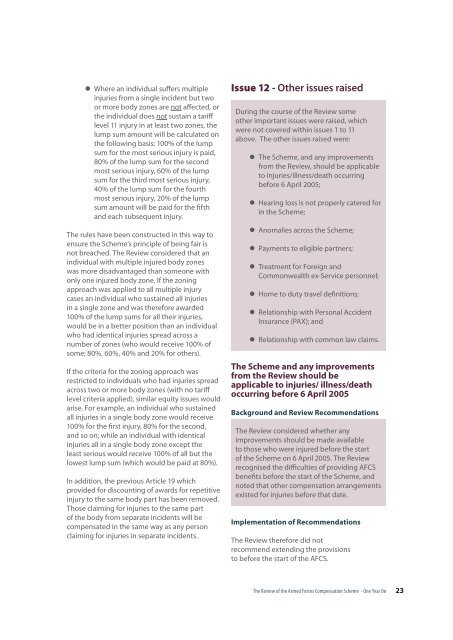
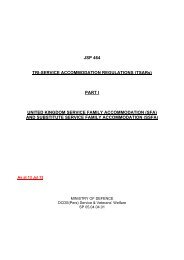
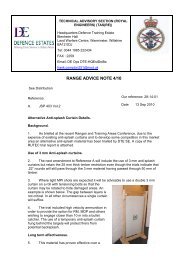

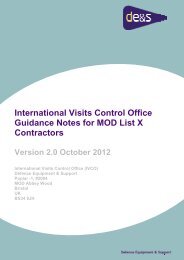

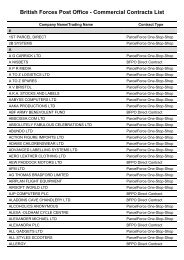

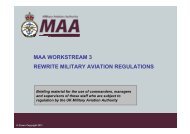

![MAA Regulatory Publications - FAQs PDF [37.3 KB]](https://img.yumpu.com/5906104/1/184x260/maa-regulatory-publications-faqs-pdf-373-kb.jpg?quality=85)
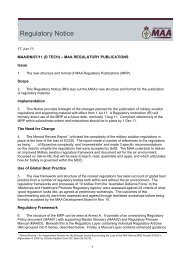
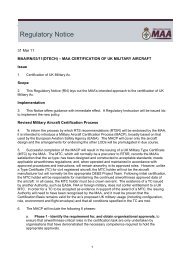
![3750 edition 6 PDF [263.5 KB] - Ministry of Defence](https://img.yumpu.com/5901071/1/184x260/3750-edition-6-pdf-2635-kb-ministry-of-defence.jpg?quality=85)
